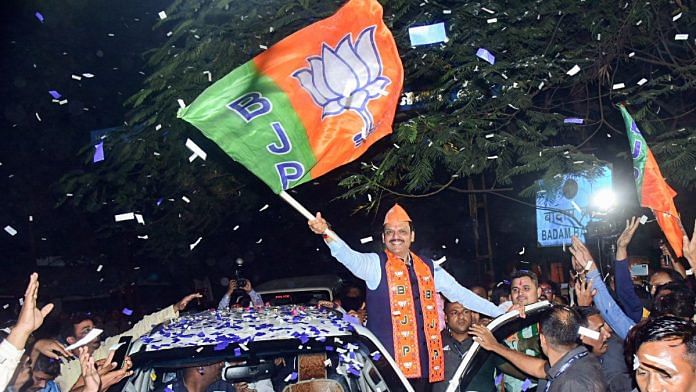The mega contest between the Maha Vikas Aghadi and the Mahayuti in Maharashtra has once again established a cardinal principle – no two elections are the same. The state that gave the INDI alliance a 43.71 per cent vote share and 30 seats in the Lok Sabha, and projected a strong victory for MVA in the assembly elections, brought the MVA’s combined seat tally to a mere 49. The MVA and Mahayuti had polled a nearly equal vote share – 43.71 per cent for MVA and 43.55 per cent for Mahayuti – in the Lok Sabha elections, even as the seat share differed sharply. However, the Maharashtra assembly elections painted a different picture, with vote shares of 35.4 per cent and 51.3 per cent for MVA and Mahayuti respectively
Going by the vote share announced by the state election commission, the Mahayuti has managed to increase its vote share in 138 assembly constituencies this time. Sharp polarisation on religious lines is being put forth as one of the main reasons for the increase in seats, with no major change in the voting percentage.
Two reasons have been highlighted for this difference, and the victory margin seat-wise – the Muslim vote bank and the campaign push by the Rashtriya Swayamsevak Sangh (RSS).
How Mahayuti stole MVA’s thunder
During the Lok Sabha polls, several assembly segments in the Lok Sabha constituency with majority Muslim voters turned the results in favour of the MVA, Malegaon being hyped as a prime example. Another reason for the deep polarisation of the Muslim vote is the fact that the two parties that were supposed to focus on this vote bank, the Samajwadi Party and the All India Majlis-e-Ittehadul Muslimeen (AIMIM), won two and one seats each. The AIMIM extended support to the Maratha reservation demand, in a bid to shed its “Muslim party’ image and gain Maratha support. But this ruse seems to have failed. The RSS conducted more than 60,000 ‘voter awareness’ meetings, significantly increasing the voting percentage in favour of the Bharatiya Janata Party (BJP) and the Mahayuti candidates.
Such massive campaign assistance was missing during the Lok Sabha polls. The Maharashtra election results emphasise the importance of this ideological fountainhead of the BJP, especially during polling season.
The massive victory of the Mahayuti reveals several intricacies of the political discourse and in particular, of the future political trajectory of parties. The pathetic performance of the Shiv Sena faction led by Uddhav Thackery (SS-UBT) poses a serious existential question for his party, which incidentally is not a patch on what it was during its founder’s time. The Eknath Shinde faction has stolen the thunder – and the bow and arrow symbol – confirming the party’s claim of being the original Shiv Sena. This will have a deep impact on the upcoming Mumbai Corporation elections.
Also read:
What do voters prefer?
Notwithstanding the similarities in costume and oratory to his uncle, Raj Thackery’s Maharashtra Navnirman Sena (MNS) fielded 125 candidates of which none won. The Vanchit Bahujan Aghadi (VBA), a coalition of parties solely dependent on Dalit votes and led by Prakash Ambedkar, had put up 200 candidates and none of them won either. Another fringe party, the Swabhimani Paksha led by Raju Shetti, also lost all the 19 seats it contested. In 11 seats with more than 35 per cent Muslim voters, the MVA won six seats while the BJP-led Mahayuti won four.
This is a clear indication of the voter’s preference for parties with a track record of performance and some amount of seriousness in their approach toward the issues of the state’s population.
This also holds some lessons for the winning coalition. The new government should list its priorities, faster and more carefully; strictly eschewing politics of polarisation and vendetta. A major realignment of parties cannot be ruled out. Several political heavyweights who have lost could become turncoats and join the Mahayuti bandwagon, only to be part of the political power and pelf.
The BJP-SSS should now work to stabilise the state’s economy and social cohesion, and strengthen agro-industries instead of indulging in vendetta politics. The agriculture and allied activities sector, with an average share of 11.9 per cent in the state economy, is extremely important to Maharashtra. The average share of the crop sector is 63.7 per cent in the agriculture and allied activities sector, while the average share of horticulture in total crop production is about 28.4 per cent. Erratic rainfall, changing weather patterns and over-emphasis on cash crops as against traditional crops have altered the income levels of farmers, leading to suicides and migration. The state urgently needs a strong agriculture policy and massive funds infusion.
The industrial infrastructure in Maharashtra has also deteriorated, resulting in the decline of the manufacturing sector, a major job provider and the backbone of the state’s economy. The state could do well to redistribute the lop-sided population concentration in a few urban centres by cutting down on the urbanisation budget. It could invest in rural infrastructure by building more healthcare centres and educational institutions. Voters’ preference for a particular party cannot be taken for granted anymore.
The author is the former editor of ‘Organiser’. He tweets @seshadrichari. Views are personal.
(Edited by Zoya Bhatti)







Make Maharashtra Vietnam.
BJP-RSS follows awkward economics. Unless they follow free-market economics, the economy will remain volatile.